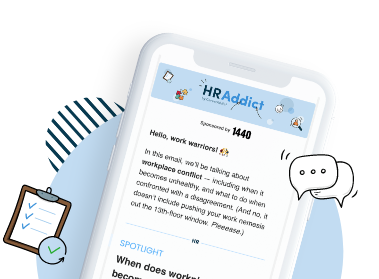This guest post is written by Eleanor Hecks from Designerly.
Different generations in the workforce face unique money challenges. While the younger generation tries to climb out of student loan debt, the older generation focuses on building their retirement savings.
Right now, 60% of U.S. adults feel uncomfortable with their level of emergency savings, which means a large portion of your team may be living with constant economic stress. Such challenges and sustained stress can quietly undermine productivity, focus, and morale, even in high-performing employees. This is why the link between employee financial stability and performance metrics like engagement, absenteeism, and turnover is too strong to ignore.
TABLE OF CONTENTS
The need for financial wellness programs
Financial wellness programs give you a competitive edge in keeping your best people and maximizing their performance. While traditional benefits like retirement plans or basic insurance have their place, they often fail to address a typical employee's everyday money challenges.
By shifting toward holistic, employee-centered programs, you can help your team build lasting financial stability, lower stress levels, and stay more engaged in their work. This approach creates a happier and more productive workplace. These programs also signal that you value your employees beyond their job titles, which can strengthen loyalty and reduce turnover. Over time, it creates a culture where people feel supported enough to do their best work every day.
However, your financial wellness activities must be flexible enough to meet everyone where they are. Higher pay might seem like the obvious fix, but it does not solve long-term financial health if your team lacks the right tools, education, and support. That is where you can step in with programs that empower employees to make better decisions and weather unexpected expenses.
As corporate responsibility and transparency take center stage in benefit design, you can lead with initiatives that genuinely improve financial well-being and contribute to employee retention and development. When employees feel supported in their financial health, it can boost morale, build loyalty, and foster a workplace culture that fuels long-term success.
Key components of effective financial wellness programs
Designing successful financial wellness program ideas starts with focusing on the areas that make the biggest impact for your team. By prioritizing the right mix of education, resources, and integration with existing benefits, you can create the kind of support that employees will use and value.
1. Education and resources
You can boost economic well-being across your team by offering tiered workplace financial education that speaks to different career stages. Early-career employees may need guidance on paying student loans and building credit. Meanwhile, mid-career professionals might focus on maximizing retirement contributions or balancing mortgage payments with family expenses.
Advanced investment strategies and estate planning can help senior staff maximize their assets. Tailoring your financial wellness activities ensures that your support feels relevant and actionable.
How you deliver this education matters as much as the content itself. Digital learning platforms allow employees to learn independently, while live webinars provide an interactive space for asking questions and sharing insights.
One-on-one coaching adds a personal touch, which allows employees to explore deeper into their economic goals with expert guidance. Combining accessible formats with targeted content will make it easier for them to engage, learn, and take action. This can lead to real, lasting improvements in their financial well-being.
2. Access to financial products and services
Your benefits package can be more impactful by giving employees tools that support various financial goals. For some, this means student loan repayment programs or high-yield savings accounts. Meanwhile, others may benefit from retirement plan auto-enrollment or an emergency savings fund.
Unsurprisingly, 81% of employers say retirement savings and planning benefits are “very important” or “extremely important” because they’re a cornerstone of long-term economic security. When you plan for financial wellness programs, aim for options that meet people where they are, so every worker can have a clearer, more achievable path forward.
Just as crucial as the offerings themselves is how you deliver them. Give your team access to unbiased financial advisors who can provide honest, personalized guidance without pushing products. Pair expert advice with modern, easy-to-use platforms that make investing, budgeting, and tracking progress less intimidating and more empowering.
When employees have the right combination of human support and smart technology, they’re more likely to engage with your programs and see real results that improve their financial stability and overall work satisfaction.
3. Integration with existing benefits
You can get more value from your benefits by ensuring your financial wellness activities are closely aligned with health insurance, mental health resources, and employee assistance programs (EAP). When these benefits work together as a seamless support system, workers experience fewer gaps in care and more opportunities to address the root causes of their stress.
The payoff goes beyond your internal metrics. Companies with engaged employees see a boost in customer satisfaction ratings and an improvement in service quality. This means that when your people feel supported, they also show up stronger for your customers.
To make this integration work, communication is everything. You must help employees understand how each benefit connects, from workplace financial education to wellness perks. Show them how using one resource can complement another, whether learning better budgeting skills to reduce stress or leveraging an EAP alongside retirement planning. When your team sees the bigger picture, they’re more likely to participate and contribute to a more productive workplace.
Real-world results: Measuring the impact
Real-world financial wellness examples show how the right strategies can deliver measurable gains in employee well-being and business performance. You can see exactly what works and why by looking at companies successfully implementing these programs.
1. Carhartt
Carhartt has built a strong financial wellness framework that goes beyond basic benefits to help employees plan for the short and long term. The company offers a generous match on associates’ 401(k) retirement plan contributions, which allows them to grow their savings more quickly.
To make retirement planning less overwhelming, Carhartt also provides complimentary access to a third-party retirement plan consultant who can offer expert, unbiased advice. These resources give employees the tools to take charge of their future confidently.
In addition to retirement support, Carhartt addresses everyday challenges through various services. Associates can access financial counseling, education programs, and debt management resources to make tangible progress toward their personal goals.
They also have a trusted third-party vendor for safe and affordable loans. The company pairs this with responsible repayment plans deducted automatically from payroll, reducing the risk of falling into high-interest debt. Combining long-term planning tools with immediate financial solutions lets Carhartt create a well-rounded benefits package that supports employee well-being.
2. Ally
The bank Ally has crafted a financial wellness strategy that balances immediate relief with long-term wealth-building opportunities. Through its Student Loan PayDown Assistance program, the company offers $100 monthly assistance for student loan repayment, with a lifetime maximum of $10,000.
In addition, Ally’s employee benefits support retirement readiness with company contributions to employees’ 401(k) plans and a match of up to 6% after one year of employment. These benefits give employees a solid foundation for paying off obligations and building future financial security.
Beyond debt repayment and retirement planning, Ally encourages workers to invest in the company’s success through its Employee Stock Purchase Plan, which offers a discount on Ally stock. This provides a potential source of additional income and fosters a sense of ownership and engagement.
Ally addresses multiple aspects of economic health, such as reducing debt, increasing savings, and building wealth. Its approach demonstrates how a well-designed benefits package can meet employees’ diverse needs while strengthening their financial well-being.
3. CVS Health
CVS Health takes a holistic approach to employee well-being by integrating economic wellness into its broader benefits framework. At the center of this effort is its Financial HUB, a centralized platform where workers can access all financial well-being programs and services in one place.
The HUB simplifies how to register for live events, use interactive calculators, and explore a library of blogs and videos. This streamlined access ensures employees find the right tools and resources without having to navigate multiple systems.
For more personalized support, CVS Health offers one-on-one coaching sessions with Certified Financial Planners. These sessions allow employees to get expert guidance on any financial topic. Those focused on retirement planning can work directly with a Retirement Education Consultant for tailored advice.
The company hosts virtual workplace financial education webcasts to support ongoing learning on dozens of topics, including credit and debt management, investing, and retirement readiness. By combining centralized resources, personal coaching, and a broad range of educational opportunities, CVS Health empowers its employees to take control of their finances and make informed decisions.
Tips for implementing a financial wellness program
Implementing economic literacy programs that resonate with employees requires a thoughtful, strategic approach. Focusing on your workforce's needs and delivering consistent support can help create programs that drive lasting engagement and results.
1. Assess employee needs and preferences
Use surveys, focus groups, and anonymized financial wellness assessments to understand the challenges and priorities across your workforce. While people often stay for competitive compensation and benefits, workers still leave due to low income. This signifies that economic stress has a significant impact on retention.
Understanding these pain points will allow you to develop financial wellness program ideas that matter to your employees, from targeted debt relief options to personalized savings tools. This will help address immediate concerns and build long-term loyalty by showing your team you’re invested in their stability.
2. Set clear goals and objectives
When you roll out financial wellness programs for employees, you must also define measurable outcomes so you can track progress and prove impact. Consider goals like increasing retirement savings rates, reducing overall debt levels, or boosting engagement with the resources you provide.
These metrics give you a clear roadmap for your program's direction and help you see what works and what needs adjustment. By setting specific, data-backed targets, you can keep your program focused, effective, and aligned with your employees' actual needs.
3. Communicate the program effectively
Create a multi-channel communication plan that uses email, your intranet, manager briefings, and corporate events to build awareness and encourage participation in financial well-being initiatives. A multi-channel approach ensures your message reaches employees on different platforms.
An optimized awareness strategy reinforces key information and makes it more likely for employees to engage with available resources. This consistent visibility boosts participation and strengthens recruitment and retention efforts by showing potential and current employees that you prioritize their long-term economic health.
4. Provide ongoing support and resources
Keep your economic wellness programs relevant by offering continuous education, easy access to advisors, and updated tools that grow with your employees’ changing needs. Providing workplace financial education on an ongoing basis helps your team make smarter money decisions.
This approach also boosts morale, encourages a forward-thinking culture, and raises overall performance. Employees notice when you invest in their long-term success, and that ongoing support can help keep them more engaged and committed to driving your organization forward.
5. Evaluate and refine the program regularly
Seek employee feedback to understand their experience in the program and identify opportunities for improved outcomes. As the economic landscape changes, you may need to update the program’s benefits and educational content to ensure it remains helpful and relevant to your organization.
As your company grows and brings in new employees, be sure to invite and incorporate their perspectives into the program so it reflects your diverse workforce and their needs.
Building lasting impact through strategic financial wellness
Financial wellness examples from leading companies prove that these programs are strategic human resource initiatives that can drive measurable business results. Long-term success comes from using data, personalization, and integration to create benefits that employees will use and value. HR leaders who move beyond compliance and trend-following can design programs that deliver lasting economic empowerment and a stronger, more engaged workforce.

